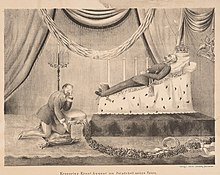catafalque

As Katafalk (masc., Pl. Catafalques from the same meaning Italian catafalco ), the specially designed generally scaffold or frame for the laying out of the deceased in a public worship or referred to during the funeral. On the catafalque the dead rests either on pillows or blankets, on a stretcher or in an open or closed coffin . Since it is like sleeping in open display on the back, the term for the Katafalk partially show bed used, particularly when the bier is shaped bed-like (cushions, canopy, etc.). Parade bed is also used as a name for a catafalque, but is mostly used for magnificent beds by rulers, who z. B. played a role in Lever et Coucher .
etymology
The origin of the word is explained differently. The Duden traces it back to a Germanization of the Italian catafalco , which developed from the Latin words catasta (German: framework) and fala (German: high framework). However, Grimm's dictionary points out that the second word component falco was developed from the Italian palco from the Old High German palcho , analogous to balcony.
history

Even among the Romans it was customary to lay the deceased on a bier called lectus funebris for several days before burial, which was raised and decorated - especially with flowers. The stretcher was then also used to transport it to the burial site.
Later, the coffin of a Roman Catholic dignitary was laid out accordingly during his exequies .
As early as the early modern period , citizens used the models of sovereigns , princes and aristocrats when carrying out burials . These deceased family members usually exhibited for several days on a specially erected catafalk called a “parade bed”. In - Christian - sacred buildings , mostly churches , an elaborate festival architecture was created for princes' burials, the so-called "mourning scaffolding", also called " castrum doloris ". At the subsequent funeral processions took secondments part of the nobility and representatives of the cities before the corpse finally in a ceremonial coffin either in a crypt or mausoleum was buried.
In the former royal seat of Hanover , funeral sermons with copper engravings have been preserved from different times , which to this day provide information about the expenditure involved, for example for Duke Johann Friedrich , who died in 1679 , his brother and regent of the Electorate of Braunschweig-Lüneburg Ernst , who was also buried in Hanover in 1698 August or Duke Georg Wilhelm, who died in Celle in 1705 . The cost of burials served one hand, paying tribute to the deceased, on the other hand, also the self-expression of their successors.

1878 in Windsor , lithograph published by Bernhard Lenzesky, Hanover
King Ernst August had a mourning scaffold built for his wife Friederike, who died in 1841, in the Hanover castle church . A lithograph made in 1878 showed the grieving Crown Prince Ernst August von Hanover kneeling in front of the parade bed of King George V. This depiction also served the purpose of " arousing sympathy for the Guelphs expelled from Hanover by Prussia ."
Examples
The most important Italian catafalque was the catafalque created in 1564 for Michelangelo by his friends. A tall and artfully decorated funeral chapel built by celebrities in the Renaissance and Baroque to protect and accompany their catafalks is called Castrum doloris .
A documentation center with a catafalk is located on the site of the former Hinzert concentration camp .
literature
- Study for: Grimaldi, Giovanni Francesco, Katafalk for Marchese Ludovico Facchinetti , Katafalk, 1644 Front page of: Obj.-Nr. 08141541; in: Italian Drawings in the Department of Prints and Drawings in the British Museum, Roman Baroque Drawings , London 1999, cat. 134 recto
Web links
Individual evidence
- ^ Description in the object of the month at the Funeral Museum Vienna
- ^ Catafalque . In: duden.de; accessed on August 18, 2017.
- ↑ Katafalk , m . In: Jacob Grimm , Wilhelm Grimm (Hrsg.): German dictionary . 16 volumes in 32 sub-volumes, 1854–1960. S. Hirzel, Leipzig ( woerterbuchnetz.de ). "Mourning scaffolding for exhibiting a corpse"
- ^ Gustav Zeiss: Roman antiquity in three periods . Friedrich Mauke, 1843, p. 593 ff . ( Full text in Google Book Search).
- ↑ a b c Andreas Fahl: Burials and burials until 1850. In: Historisches Museum am Hohen Ufer (ed.): Don't weep, we'll see each other again. Mourning culture in Hanover from 1600 to today (= writings of the Historisches Museum Hannover , issue 24). Landeshauptstadt Hannover, Hannover 2005, ISBN 3-910073-26-3 , pp. 21-26; here: p. 22f.
- ^ Sally J. Cornelison: Art and the Relic Cult of St. Antoninus in Renaissance Florence. Ashgate Publishing, ISBN 978-0-7546-6714-8 , pp. 276ff
